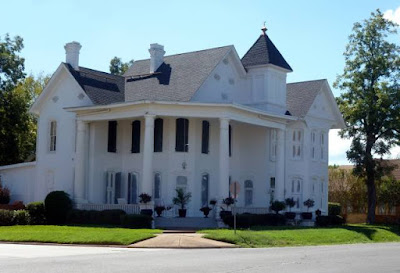Texans are Texans
first, then American. They know the state’s history: they declared independence
from Mexico in 1836, initially losing to superior Mexican forces at the Alamo
(get those Davy Crockett hats out of the attic) but beating them later in that
year. From 1836 to 1845 Texas was an independent republic, adopting the single
star flag from which the “Lone Star State” description comes. The lone star
symbol appears everywhere either on its own or in the state flag. This owner
has painted his garage as the flag.
Practically all the USA countyside is fenced off as
private property, with very few public footpaths or rights of way other than in
County, State or National Parks. Texans fought harder than most to claim and retain
their land, and are sure gonna defend it. This is not an unusual notice.East Texas is rural with many pleasant small towns, like Rusk below. You perhaps can’t read the sign on the bottom right: “Ammo Sold Here”. Guns are part of Texan culture, as you might expect, but we haven’t noticed them much in evidence or being openly carried as they are legally entitled to do in this state.
Housing standards vary more in the USA than in the UK. There are large numbers of residential trailer parks and most of the sites we stay on have a substantial permanent element. There are also many magnificent houses, like the one shown next and a good number of solid brick homes set in pleasant neighbourhoods.
At
the lower end are the individual cabin type dwellings with some land. There
are large numbers of these, of widely varying designs, everywhere in the south
where winters are short and mild.
The
various parks mentioned earlier are generally well maintained and have good
walking and cycling paths. The downside is there is always a drive to get
there, but Americans drive everywhere so that wouldn’t be viewed as a problem.
The first park shown below is Tyler State Park, with a pretty lake that we walked around.
Next up, Jim Hogg Park, with tall trees and woodland
glades.
The
parks are often located in places of local historical significance, in this
case the Jim Hogg settlement. Good old Jim, whoever he was. The house is a
reconstruction but the equipment outside is original- it’s for crushing sugar
cane. Sugar cane is a semi-tropical crop and it is easy to forget how far south
we are here. We are on the same latitude as Agadir in Morocco.
This
part of East Texas is called the piney woods, rolling hills and lush grass. The
downside is heat and humidity in summer, but it makes for great cattle rearing
country. We end with a photo of a Mexican wedding photoshoot against a backdrop
of those wooded hills and technicolour grass.










No comments:
Post a Comment